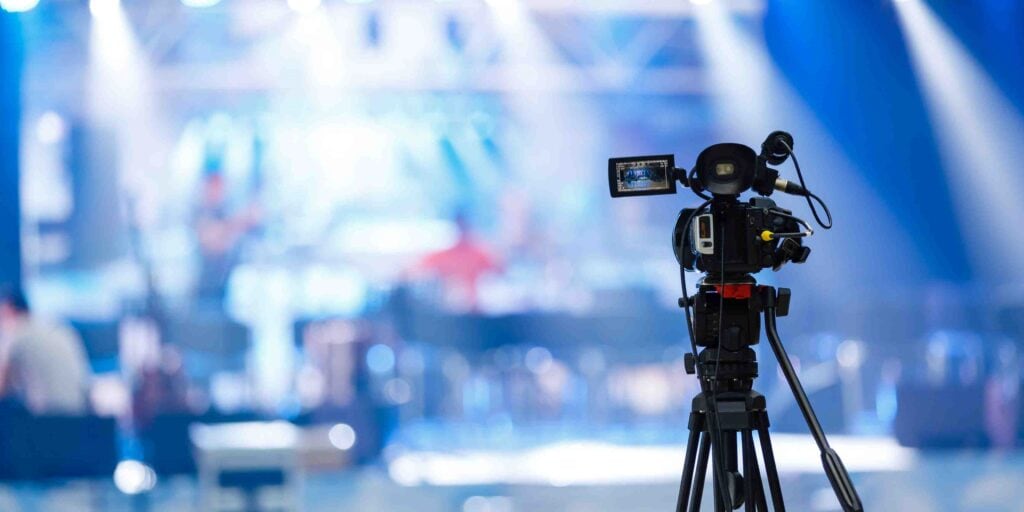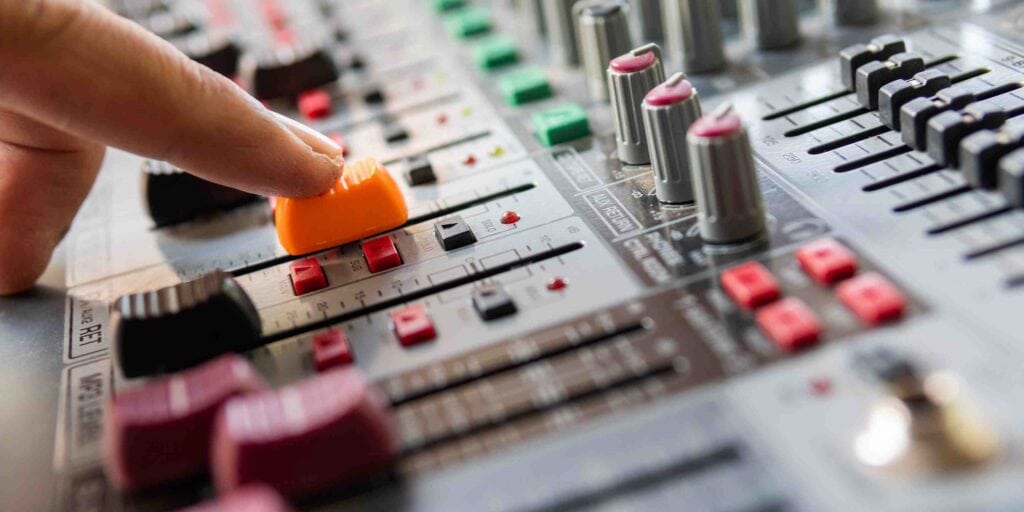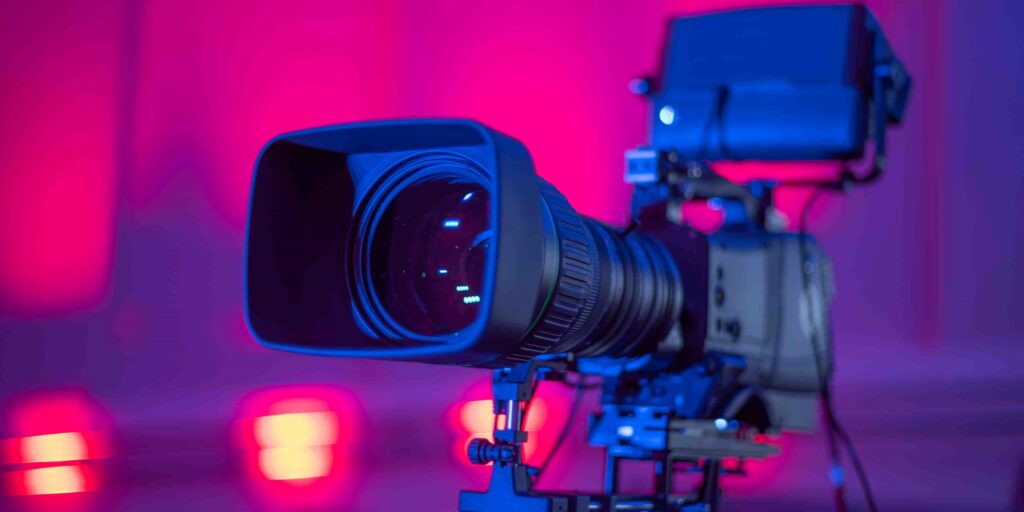Live-streaming production and 3D virtual studio set production services are important tools for delivering engaging visual and graphic elements that can make or break the success of a live event. When it comes to capturing attention, nothing compares to the impact of high-quality visuals that have been carefully designed and tailored to an audience’s needs. Here we will discuss how to create engaging visuals and graphics for streaming events, as well as tips on maximizing audio quality in your video stream, essential lighting techniques for professional video productions, and mistakes to avoid while setting up a livestream environment.
What is live-streaming production?

Live streaming encompasses many different components, such as camera setups, software options for editing videos, broadcast technology, special effects, sound engineering, etc., all of which come together in order to produce a live stream event. The goal is essentially the same: to create visually stunning content with compelling audio that captivates viewers from start to finish. It allows you—the producer—to control every aspect of your presentation from beginning to end without relying solely on outside sources or hardware devices such as microphones or cameras. Additionally, you can also incorporate multiple angles into one stream in order to enhance the entire viewing experience.
Benefits of Using a 3D Virtual Studio Set for Livestreaming
Using a 3D virtual studio set can be the perfect addition to any live streaming event. Not only can they provide an interactive and realistic experience, but they also allow you to customise your visuals to fit any size audience or type of content you’re looking to create. This flexibility gives you limitless potential when it comes to visual creativity. Additionally, these sets come pre-made with high-quality graphics, making them easy and convenient to use in lieu of creating custom backdrop designs from scratch each time.
How to Select the Right Camera Setup for Your Stream
When selecting the appropriate camera setup for your livestream needs, there are several factors that must be taken into consideration, such as budget, desired effect or look, field of view (FOV), lighting requirements, etc. Generally speaking, if you are streaming events, then multiple cameras may be necessary for capturing different angles at the same time, whereas if you are recording instructional videos or webinars, then one stationary camera should suffice in most cases.
How to Create Engaging Visuals and Graphics for Streaming Events
There is no one-size-fits-all solution when it comes to creating engaging visuals and graphics for a stream event, as this will depend largely on the type of content you are producing and the audience you’re trying to reach. However, there are a few basic rules, such as keep it simple, maintain high contrast between text and background,” and “use bold visuals that capture attention. Additionally, consider utilising 3D virtual studio sets for even more vivid graphics or incorporating creative elements such as animation, green screen technology, etc.
Tips on Maximising Audio Quality in Video Stream

Another important factor in ensuring a successful streaming event is getting the audio quality just right so it does not distract from the visuals. The key here is to utilise a microphone with good pickup power and ensure any ambient noise present in the room has been minimised prior to starting your stream. Furthermore, if background music will be used, it should only be added once all other sound levels have been set, otherwise they can interfere with each other, creating an unpleasant listening experience for viewers.
Common Mistakes To Avoid When Setting Up A Livestream Environment
The most common mistakes made when setting up personal or professional streaming environments include incorrect camera placement, inadequate lighting, poor audio setup, and a lack of backups, which could cut off the live stream unexpectedly. Without taking these elements into account before going live, this could cause significant disruptions that ultimately undermine whatever message was being relayed during the event. Therefore, it is important to take all steps necessary to avoid any potential issues from arising in the first place.
Essential Lighting Techniques for Professional Video Productions
Lighting techniques for professional video productions can vary depending on the desired look; however, there are a couple of universal practises that should generally be applied, such as using multiple light sources when recording indoors and making sure lighting is evenly distributed across all subjects in frame. Furthermore, utilising backlighting or various colour gels can also help create silhouettes and interesting highlights, respectively, that draw attention towards specific elements within a scene.
Choosing the Best Software Options for Video Editing
These days, from Adobe Premiere Pro to Final Cut Pro X, there are numerous software options available for editing videos, with different levels of capabilities, features, and price points at your disposal when it comes to choosing what’s right for you. After determining factors like budget, timeline, etc., do some research into each program’s user interface or experience, type of file formats supported (if necessary), and compatibility with other devices or software before picking one over another so you know exactly what to expect post-purchase—no surprises afterwards.
What Are the Different Types of Broadcast Technology and Why Is It Important?
Broadcast technology is the process of sending audio and visual signals to a receiving device such as television sets, computers, and mobile phones in order to receive or transmit data from one source. Examples include cable networks, broadcast radio, satellite TV services, etc. This type of technology is important because it allows individuals to share information with an array of people around the world at any given time, making communication with others much easier than ever before.
What Goes Into A Successful Live-Streamed Event?
Putting together a successful live streaming event requires careful planning beforehand—right down to the smallest details. From selecting appropriate streaming platforms and software to confirming bandwidth requirements and setting up camera angles correctly beforehand, all need to be taken into consideration, otherwise you won’t be able to capture your audience’s attention throughout the duration of your presentation. Additionally, having backup plans in case something goes wrong mid-stream will help ensure that nothing derails your event, no matter what happens once you go live.
Live-streaming production and 3D virtual studio set production services are essential tools for delivering engaging visuals and graphics that can captivate any audience. When done correctly, they can be the perfect addition to any streaming event, providing an interactive experience with more vivid effects than ever before. Keep in mind that there is no one-size-fits-all solution here, so experiment around until you find what works best for your particular needs. From choosing the right camera setup to creating engaging visuals and maximising audio quality, it’s important to pay attention to each detail when going live; otherwise, small mistakes can quickly derail an entire presentation if not caught beforehand.
FAQs:
Choosing the best streaming platform depends on numerous factors, such as budget, desired feature set, target audience size, latency requirements (time delay), ease of use, etc. Some popular options include Facebook Live, Periscope or Twitter Live Video (free), or YouTube Live (which requires an account). If you are looking for more specialised services, such as visual effects or studio-quality videos, then paid platforms like Vimeo’s Livestream or Twitch Pro could be worth considering too. Ultimately, it is dependent on what features you need most from your broadcast to make sure it meets all of your expectations and runs smoothly without any unexpected disruptions during the production process.
In order to record clear audio during a live stream broadcast, there are a few different items you will want to pick up. A quality microphone, whether it is USB or XLR-style, will do the job. You can also consider sound capsules that you attach directly to your device for convenience. Additionally, a preamp and an impedance matching device are important pieces of kit in order to get the best audio during recording sessions as they help reduce noise, which can interfere with capturing clear sound.
In order to create a professional-looking 3D virtual studio set, there are several considerations that need to be taken into account, such as content selection and storyboarding, camera placement, lighting design, and texturing methods needed for creating surfaces that look believable from different angles. It is also important to think about the distance from the cameras so any movement appears smooth when viewed onscreen. Investing in additional software tools for video editing projects like Adobe After Effects or Final Cut Pro X may significantly improve the end result of your production by adding key elements like transition effects or animations, which help keep viewers engaged throughout each segment of your broadcast event series.
When it comes down to selecting what type of software programme works best for editing videos, it depends largely on the nature of your project and what features you plan to use most often. If you’re looking to add animations or elements with 3D rendering, then programmes like Adobe After Effects or Apple Motion are popular choices. If your production is more focused on linear editing functions, then Final Cut Pro X or Avid Media Composer may be better suited for your needs.
When putting together a live-stream setup, one key element would be selecting an appropriate location that allows the camera crew enough room for various angles, as well as ensuring that it provides good lighting conditions and sound insulation from any background noise sources. Additionally, make sure all cables are secure and any monitors used have their settings adjusted correctly in order for viewers to get the best image resolution possible. It is also important not to forget about keeping energy levels high during recordings, so encourage performers with positive reinforcement whenever necessary.
Definitely yes. Lighting has such a great influence on how our imagery looks at playback time, which is why having proper illumination plays such an important role. When considering what type of lighting should be used for your project, it’s important to consider the size and shape of your environment as well as any colour temperature issues. It is also worth investing in lighting that can be dimmed or adjusted, such as LED panels or softboxes, which help you set the right tone for each scene without sacrificing quality.
In order to stream audio and video online successfully, several technical processes are needed, such as compression formats, streaming protocols, and codecs (compressors and decompressors), which help reduce data size and improve playback speeds while still maintaining overall quality. When deciding what type of encoding settings should be used during live stream, certain variables need to be taken into account, such as network bandwidth available at the time of broadcast, target viewing devices, and so forth. Additionally, different platforms may have their own specific requirements regarding bit rate, frame rate, etc., so consulting a professional before starting would be highly recommended.
Spring Forest Studio offers top-notch customer service with our experienced professionals, who provide all sorts of advice, whether it’s selecting equipment or setting up an entire broadcast environment from scratch. Our team of experts can help guide you through the entire process from start to finish, including things such as pre-event testing, making sure all equipment is functioning correctly, and setting up live streaming platforms like OBS or Webex Events.
Extra cameras are a great way to get creative with your production and add another level of dynamism for viewers. When considering additional hardware, it’s important to think about what types of angles would be beneficial in terms of getting the best footage possible. Investing in multiple field cameras helps cover more ground, while using studio-grade cameras (such as those with 4K resolution) makes it easier to zoom in on particular details without compromising image quality.
When creating visuals that capture audience attention, there are several elements that need to be taken into consideration, such as vibrant colours, motion graphics, animation effects, and other graphical features like titles or logos that act as points of reference during viewing sessions. Additionally, employing effective transitions between clips also helps keep things interesting when switching scenes throughout the broadcast. It’s also worth experimenting with different camera angles too—like close-ups, aerial shots, or some other creative techniques—to get the most visually appealing results for your project.

